52 Weeks of Historical How-To’s, Week 12: La Vénerie
The subject of this week’s blog is a rather interesting manuscript, bound with three printed works, and takes me back to my postgraduate days of studying late-mediaeval veterinary medicine. All four items are bound together in limp velum, with traces of the ties remaining. On the title page of the first work is the inscription “Will: Moore”. William Moore (c. 1640-1684) was Archdeacon of St Andrews, and a former student of St Salvator’s College. In 1681 Moore bequeathed his books to the College, amongst which was this item.
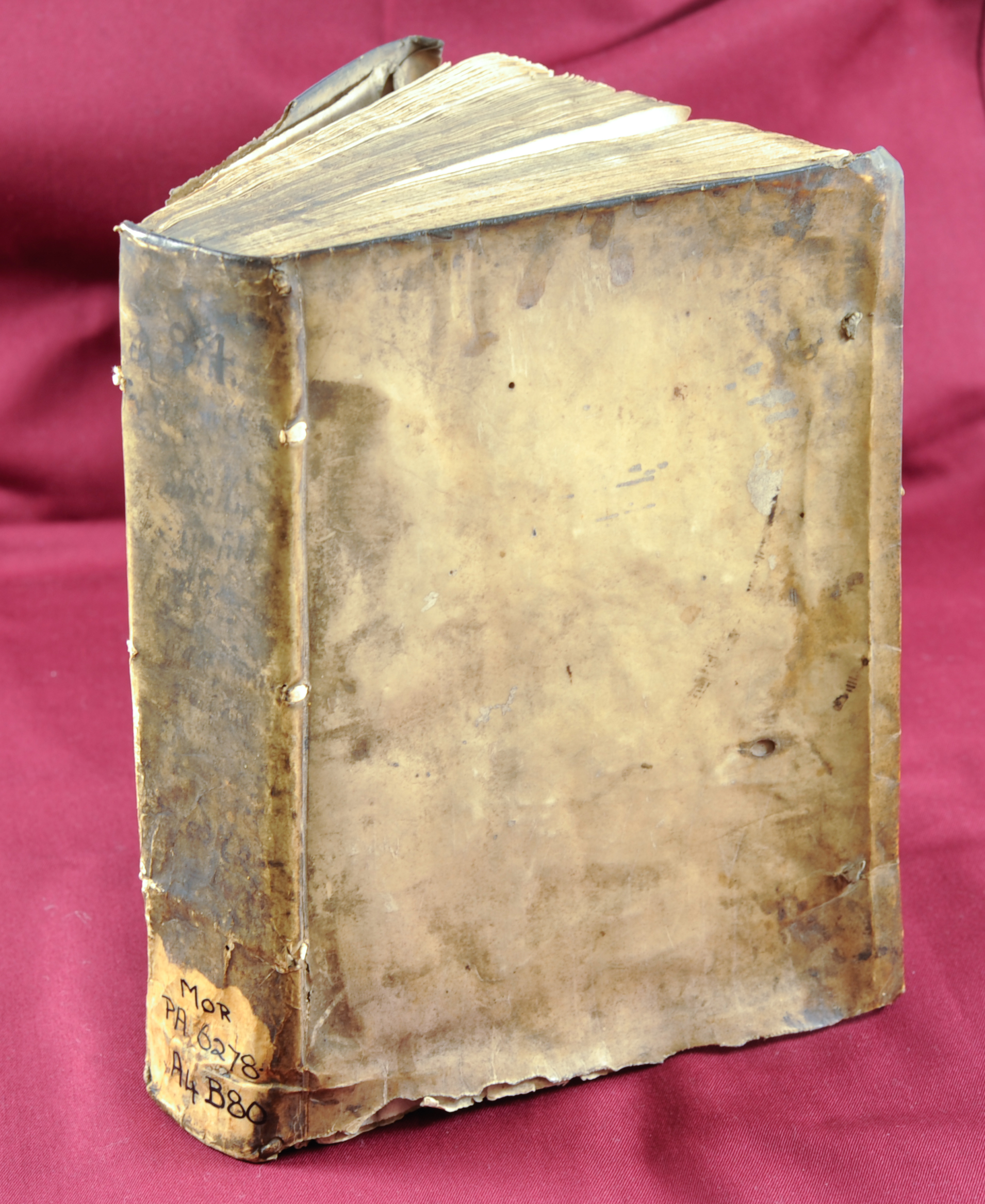
The binding is late-sixteenth to early-seventeenth century, indicating that the works were bound together before Moore acquired the volume. A previous owner had clearly had an interest in treating the ailments of dogs (in particular hounds), for this is what forms the fourth item. Unlike the previous three, this is a hand-written document. Entitled “Recepte po[u]r les chiens: receptes pour guarir les chiens de plusieurs maladies par Jacques du fouilloux escuier, seigneur dudit lieu” this is actually part of a larger work by Jacques du Fouilloux – his La Vénerie, first published at Poitiers in 1561. It went through many editions in the sixteenth and seventeenth centuries, those after 1573 having some chapters borrowed from Le Livre de Chasse of Gaston Phébus. Indeed, in 1575 George Gascoigne adapted du Fouillioux’s work into English, under the title The noble arte of venerie of hunting. It is usually bound with George Turberville’s The booke of falconrie or hawking, and as such is sometimes attributed to him.
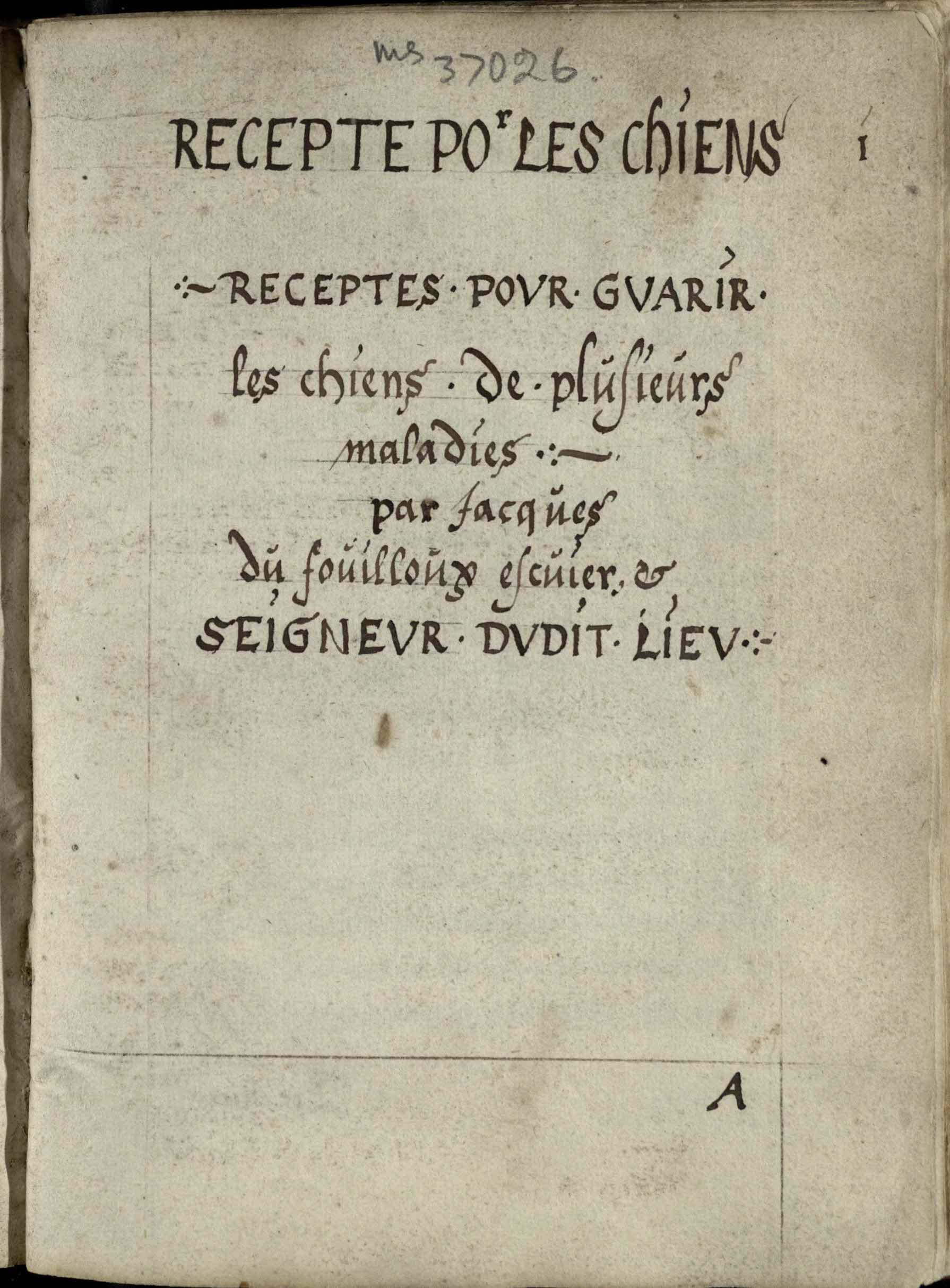
La Vénerie is a hunting treatise, and is concerned with more than just the ailments of hunting dogs. It begins by discussing different dogs, first by colour (white, dun, grey, and black), before considering such matters as food and housing. Then begins the discussion on hunting the various types of game – deer, boar, hare, fox, and badger. Finally, in an annexe, come the receipts for curing dogs of many ailments, the section which is found in our manuscript.
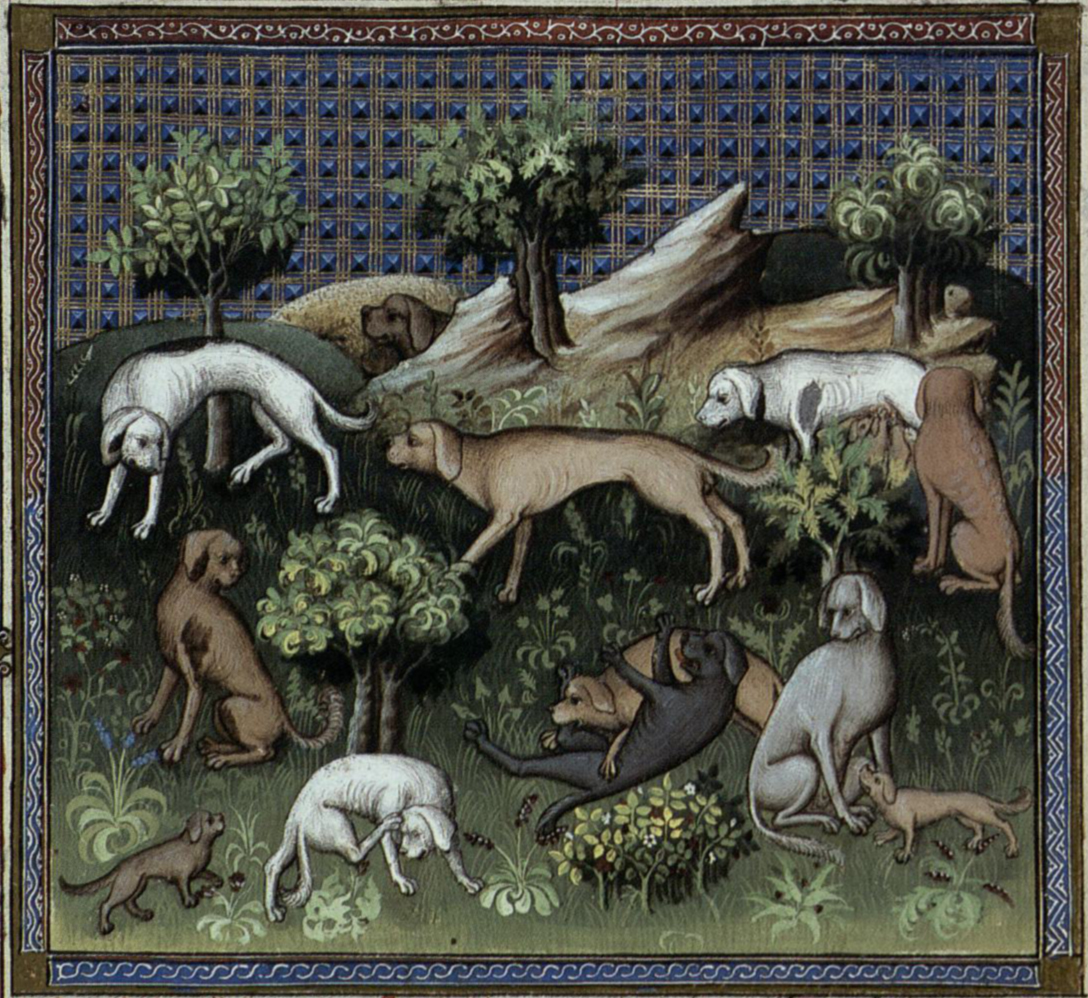
The recipes are written in a very neat 16th century French secretary hand, with margins ruled in ink and the text contained within this area. The scribe has also given a running title, catch words, and signatures, although he appears to have misunderstood the last. Signatures (letters, numbers, or symbols at the bottom of the page) were intended to indicate to the binder the order in which gatherings were to be bound, and by their nature always cover an even number of leaves; but the letters of the signatures in this manuscript each cover 5 leaves (being signed A, Ai, Aii, Aiii, Aiiii, etc.), and thus must have been added after the gatherings were assembled.
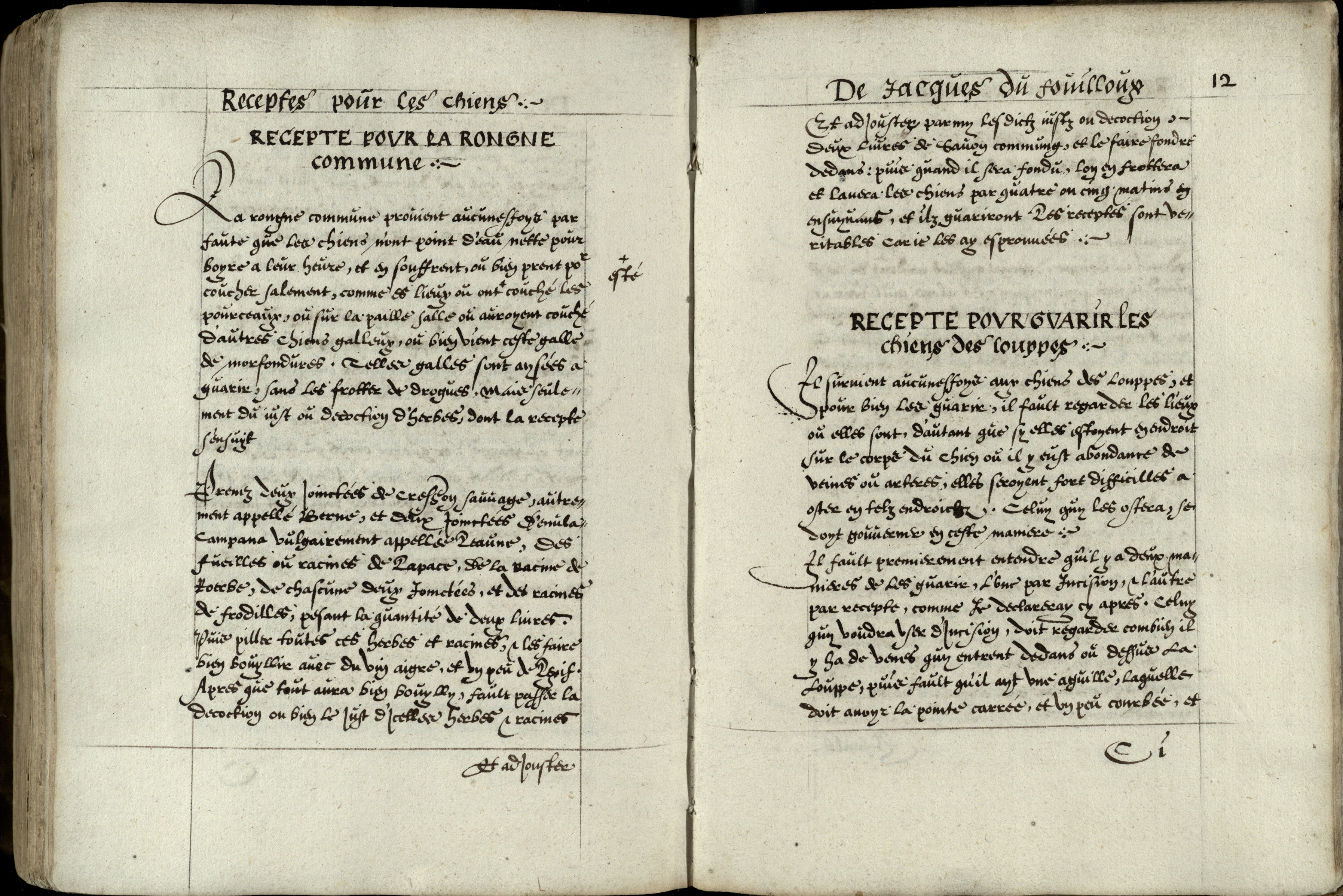
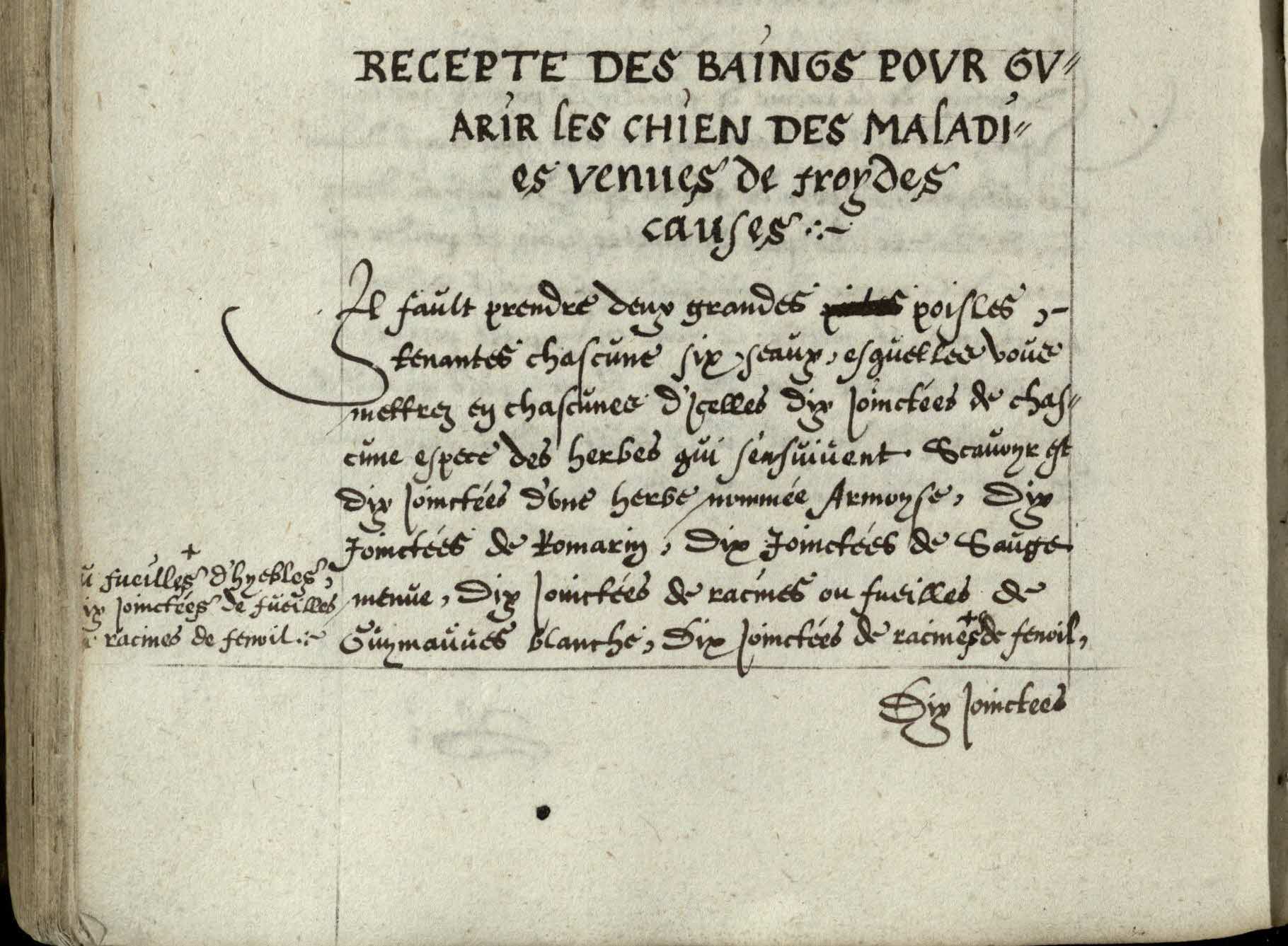
The copy is also not without its scribal errors; on f. 7v a word has been crossed out, and later in the paragraph a missed sentence is copied in the left margin. The beginnings of the words are missing, indicating that the manuscript was trimmed before being bound in its current form.
The text opens with a discussion of madness (rage – rabies), which was thought to be the most common ailment to afflict dogs – indeed, Gaston Phébus, too, opened his section on ailments in Le Livre de Chasse with a discussion of the same ailment. The first two, hot madness (rage chaude) and running madness (rage courante) are both incurable. The author describes the symptoms, but gives no remedies. The other five kinds of madness – dumb madness (rage mue), falling madness (rage tombante), withering (flastre) [Gascoigne translates this as “Lanke madnesse”], sleeping madness (rage endormie), and rheumatic (reumatique) – are all curable, and as such remedies are given (that for the latter being a bath also suitable for dogs suffering from ailments brought about by cold causes).
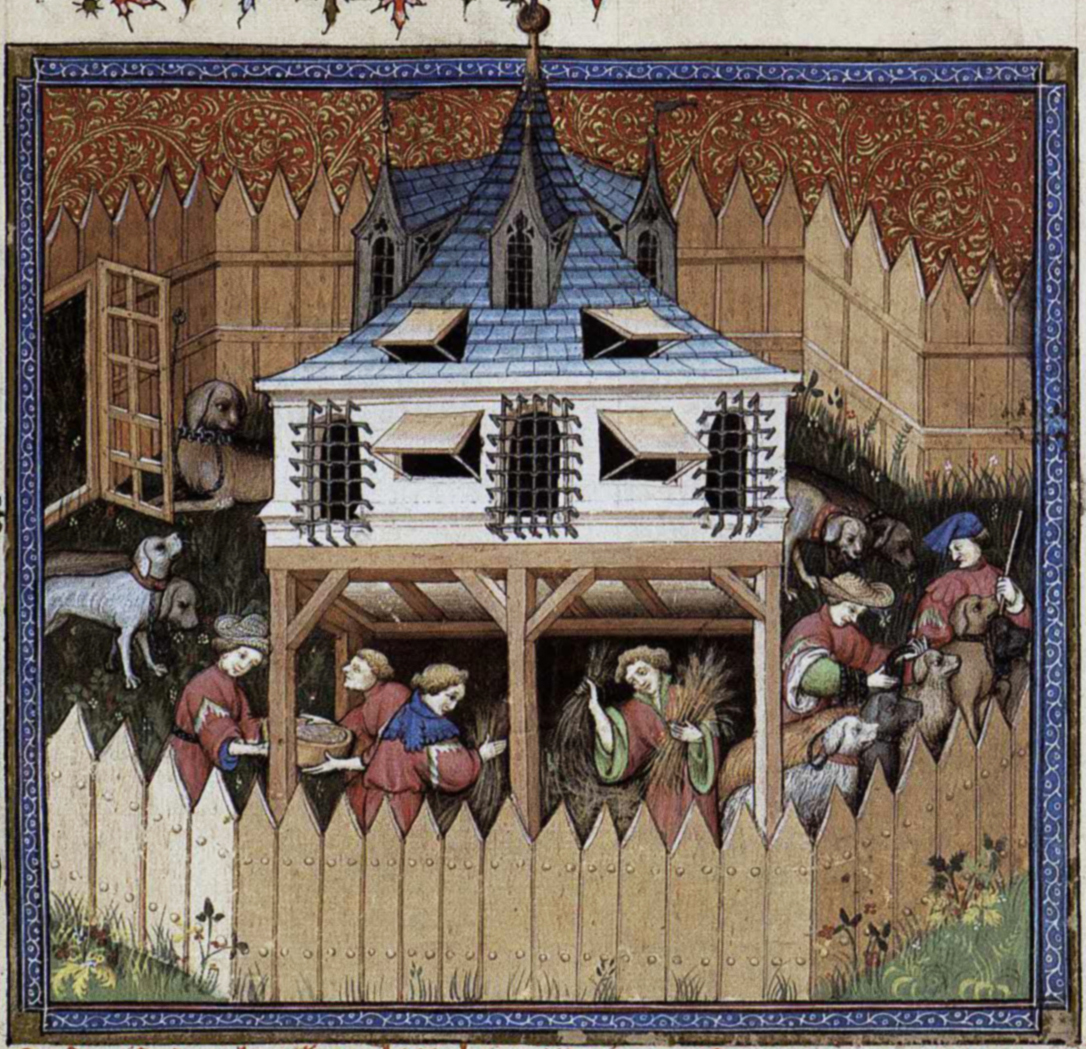
As is to be expected in a hunting treatise, some ailments were as a direct result of being out on the hunt. Thus we find a remedy to heal dogs from the bite of boars and other biting beasts (Recepte povr faire gvarir les chiens de la morsure de sangliers & autres bestes mordantes), whilst another deals with dogs which have been broken and trampled by boars, without causing wounds (Recepte povr les chiens qvi ont esté rompuz & foulez des sangliers, sans estre blesses). Ailments still common today are also found, such as soreness within the ears (mal dedans les oreilles), and fleas (puces) and lice (poulx). The author was also aware that some dogs would be bitches, and so a recipe to prevent them coming in to heat is given; over a period of nine mornings the bitch was to be given nine grains of pepper, placed in cheese or something else.
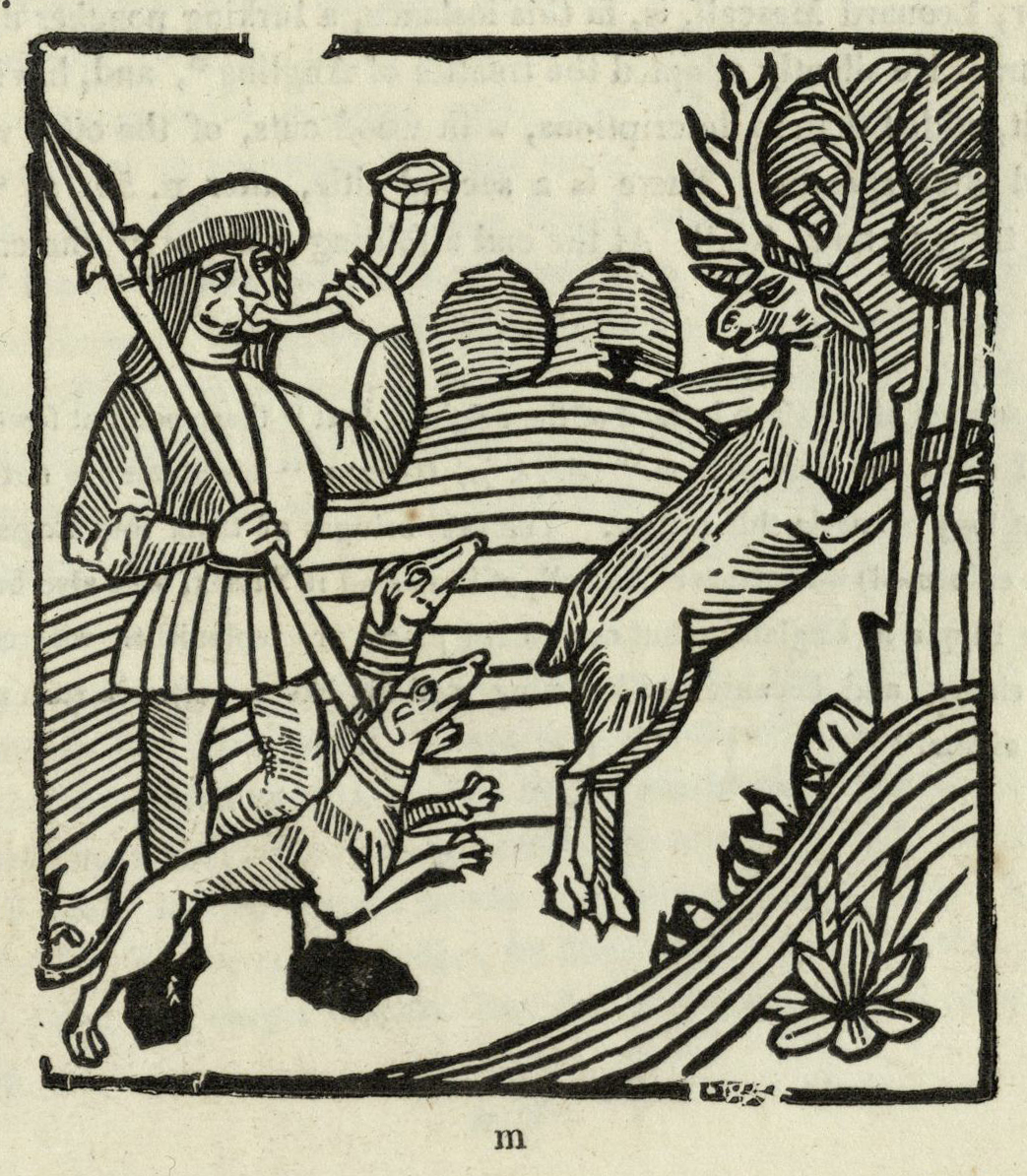
The majority of remedies are herbal in nature; that for wounds in dogs calls for the juice of the red cabbage (chou rouge), which was thought to be “the sovereign balm for the wounds of dogs” (le souuerain Baume pour les playes des chiens) because the flesh of dogs was hot and dry, whilst the red cabbage was hot and moist. This alludes to the notion of humoral theory. In addition to herbal remedies, surgical procedures are also to be found in the text. A dog suffering from “louppes” (Gascoigne notes “I take this Wolfe to be that which we call a Wenne”, i.e. a lump or protuberance on the body) was to have this removed with a razor, after any veins leading to the ‘louppe’ had been tied using a needle (which had a square tip and was a little bent) and thread. After removal of the ‘louppe’ the cut veins were to be cauterised with a hot iron before a plaster of dragon’s blood,egg yolks, ashes of burnt linen, and vinegar was applied.
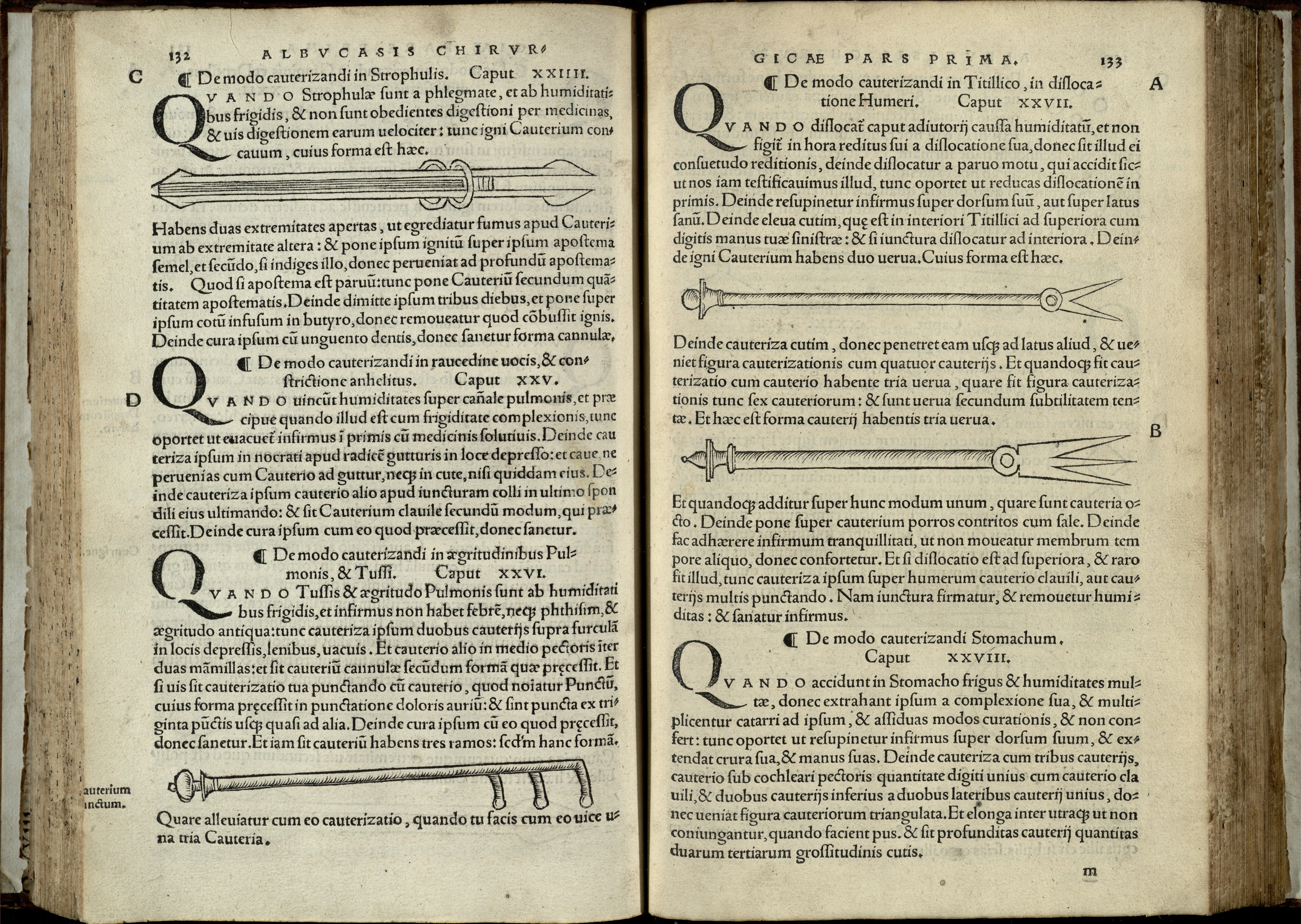
One remedy stands out in particular, being neither herbal nor surgical. Instead, it is a charm to prevent madness in dogs bitten by a mad dog, which the author learned from a gentleman of Britain. It involved writing two lines of inscription (y ram qui ram cafram cafratrem cafratrosque), putting this in an egg omelette (omelette doeufz – Gasgoigne translates this as “egshell”), and making dogs which had been bitten by mad dogs swallow it. The words of the charm appear to be gibberish, which was not uncommon in charms – indeed, their unintelligibility may have contributed to the efficacy of the charm.
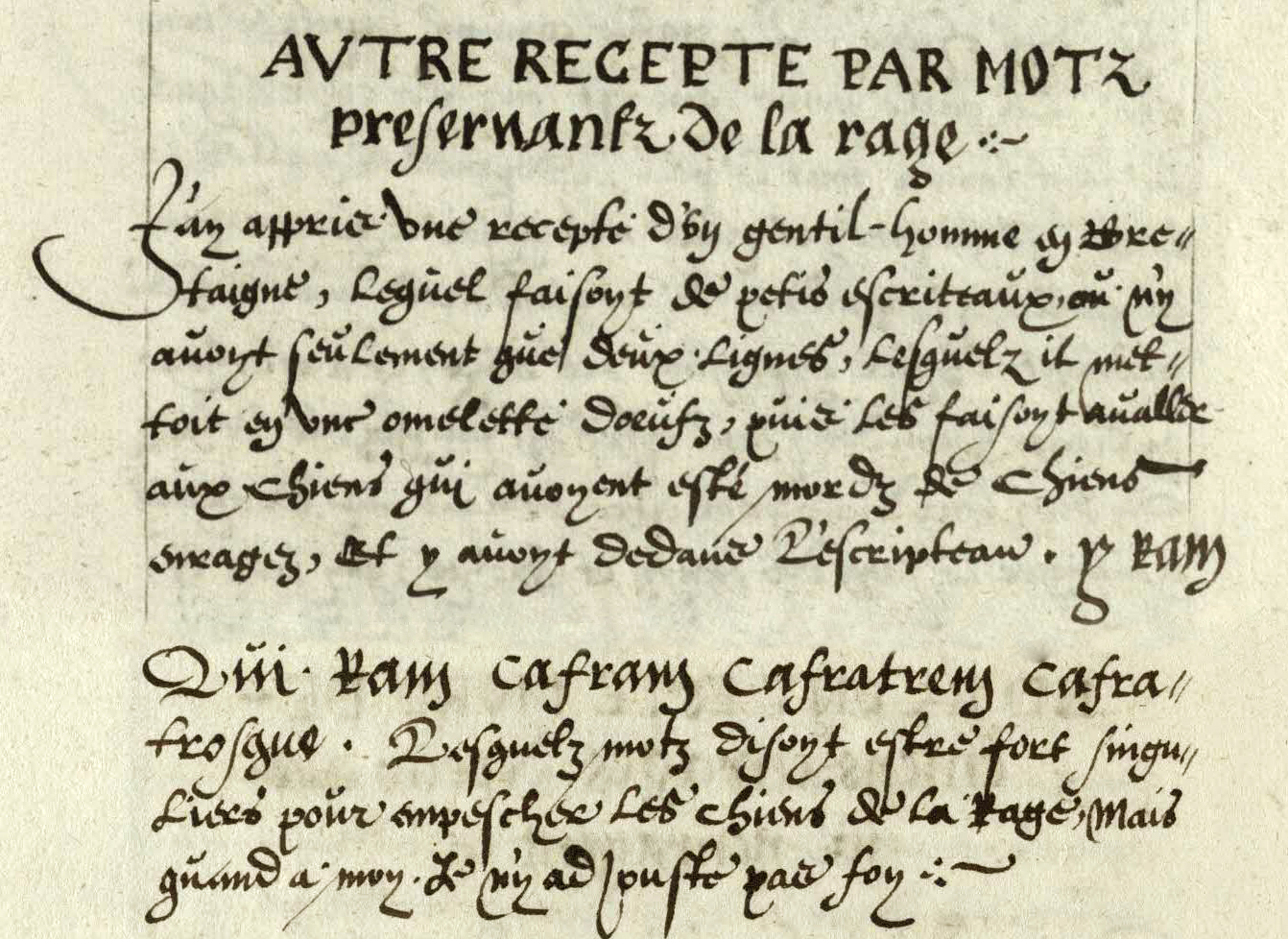
J’ay appris vne recepte d’un gentil-homme en Bretaigne, lequel faisoyt de petis escriteaux, ou n’y auoit seulement que deux lignes, lesquelz il mettoit en vne omelette doeufz, puis les faisoyt aualler aux Chiens qui auoyent esté mordz de Chiens enragez, et y auoyt dedans l’escripteau, y ram qui ram cafram cafratrem cafratrosque. Lesquelz motz disoyt estre fort singuliers pour empescher les Chiens de la Rage, mais quand a moy je n’y adjouste pas foy
This charm struck me as being something rather fun to replicate, so I had a go. I found quill and ink, and wrote out the lines as neatly as possible (not as easy as you’d think!). The charm doesn’t say which words are to appear on which line, so I chose to make two lines fairly equal in length. I then set about making an omelette, and inserted the paper before folding the omelette over. I was now ready. The only thing missing was the mad dog. Ah well, I would just have to rely on du Fouilloux’s beliefs in the effectiveness of this remedy – which, if truth be told, do not seem to be positive, for he wrote: “These words are said to be singularly powerful for the prevention of madness in dogs, but I cannot credit them with my own faith”.
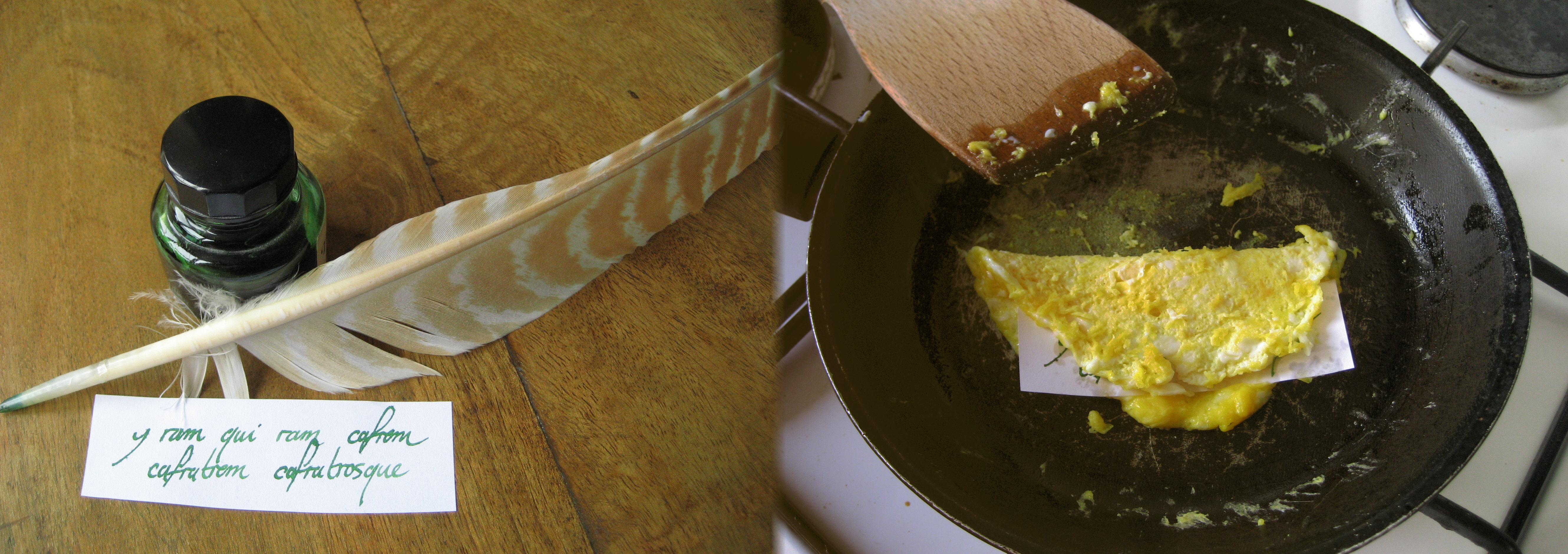
This is a fascinating work. It not only sheds much light on the veterinary treatment of hunting dogs in sixteenth-century France, but also gives an insight into the interests of an individual, who chose to record this particular section of du Fouilloux’s La Venerie. If you find yourself in St Andrews, why not come and have a look at it?
~ Briony Aitchison
Lead Cataloguer – Lighting the Past